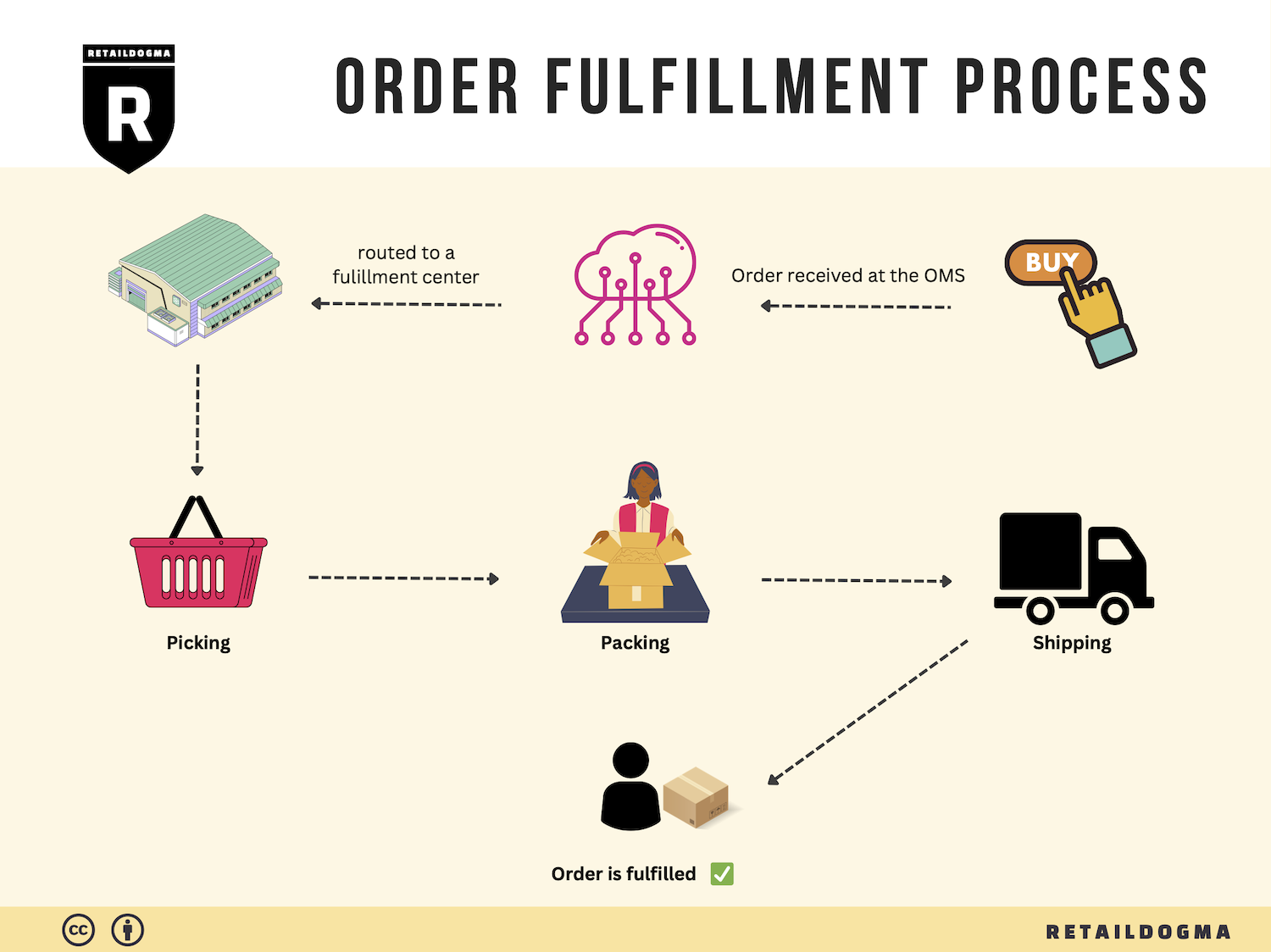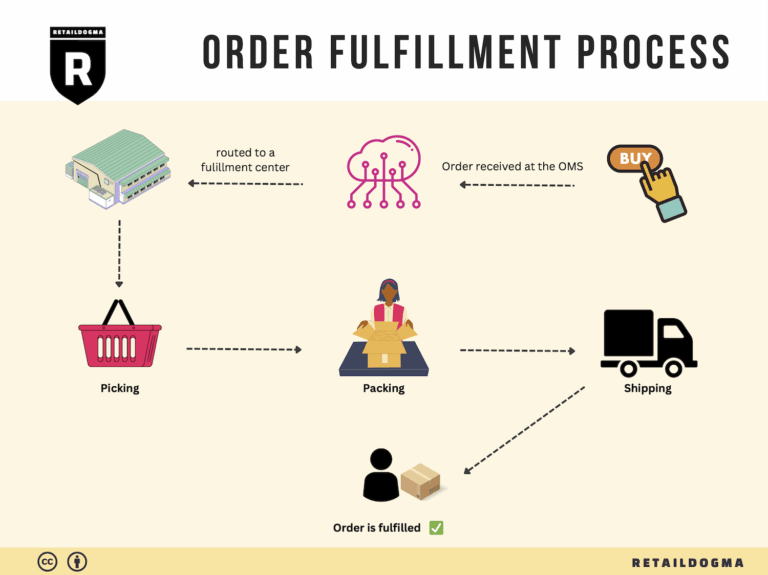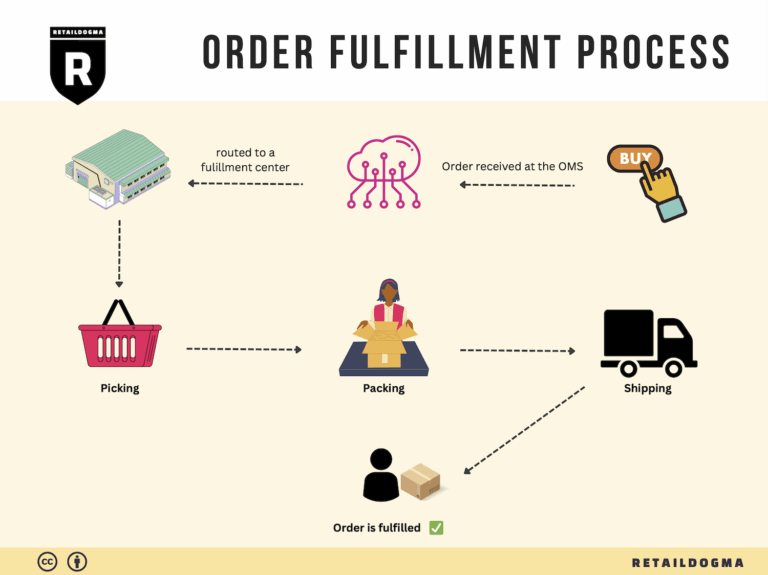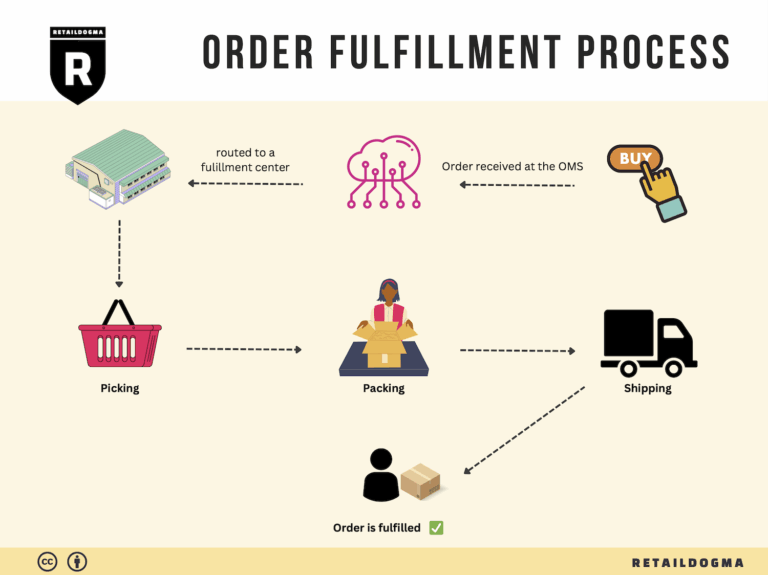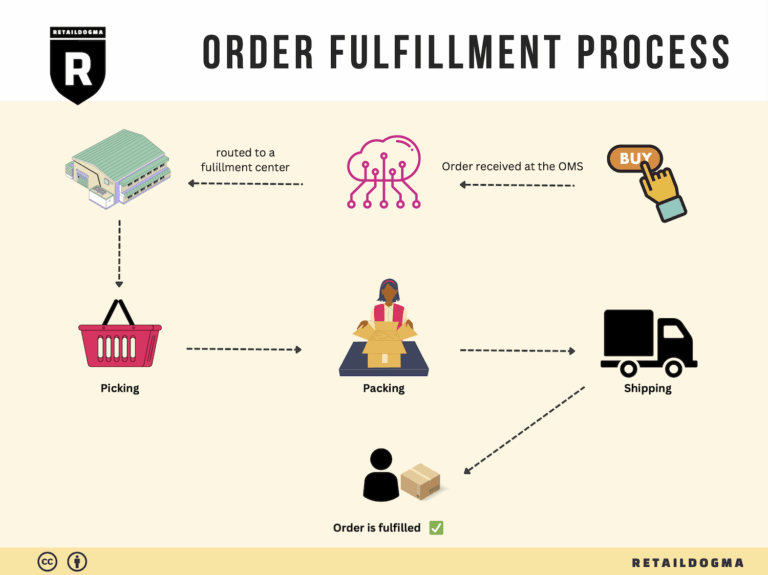What Is A Fulfillment Center? A Complete Guide (2025)
What is E-commerce Fulfillment? An Introduction for Growing Businesses
Understanding the Challenges of E-commerce Fulfillment
As a growing online business owner, the excitement of increasing sales can quickly turn into a daunting challenge. One of the most common pain points faced by e-commerce entrepreneurs is the overwhelming burden of packing and shipping orders. The logistics of getting products into the hands of customers can become a complicated and time-consuming task, diverting your focus from core business activities such as marketing and product development.
At its essence, e-commerce fulfillment is the process of getting a product from your inventory to your customer’s doorstep. This includes everything from receiving orders and processing payments to picking, packing, and shipping items. As your business scales, the fulfillment process can become increasingly intricate, requiring strategic planning and execution to ensure customer satisfaction.
This guide aims to demystify e-commerce fulfillment for growing businesses. We will explore various fulfillment models, including Third-Party Logistics (3PL) and Fulfillment by Amazon (FBA), to help you understand which option may be best suited for your business needs. Additionally, we will discuss the core services that fulfillment partners typically offer, such as inventory management, order processing, and returns handling.
Choosing the right fulfillment partner is crucial to your success. We will provide practical insights on how to evaluate potential partners based on factors like their operational capabilities, technology integration, and experience with international shipping, especially if you’re looking to expand into markets like South Korea.
Pricing is another key consideration in the fulfillment process. We will break down the various costs associated with fulfillment services, from storage fees to shipping rates, and provide tips on how to manage these expenses without compromising on service quality.
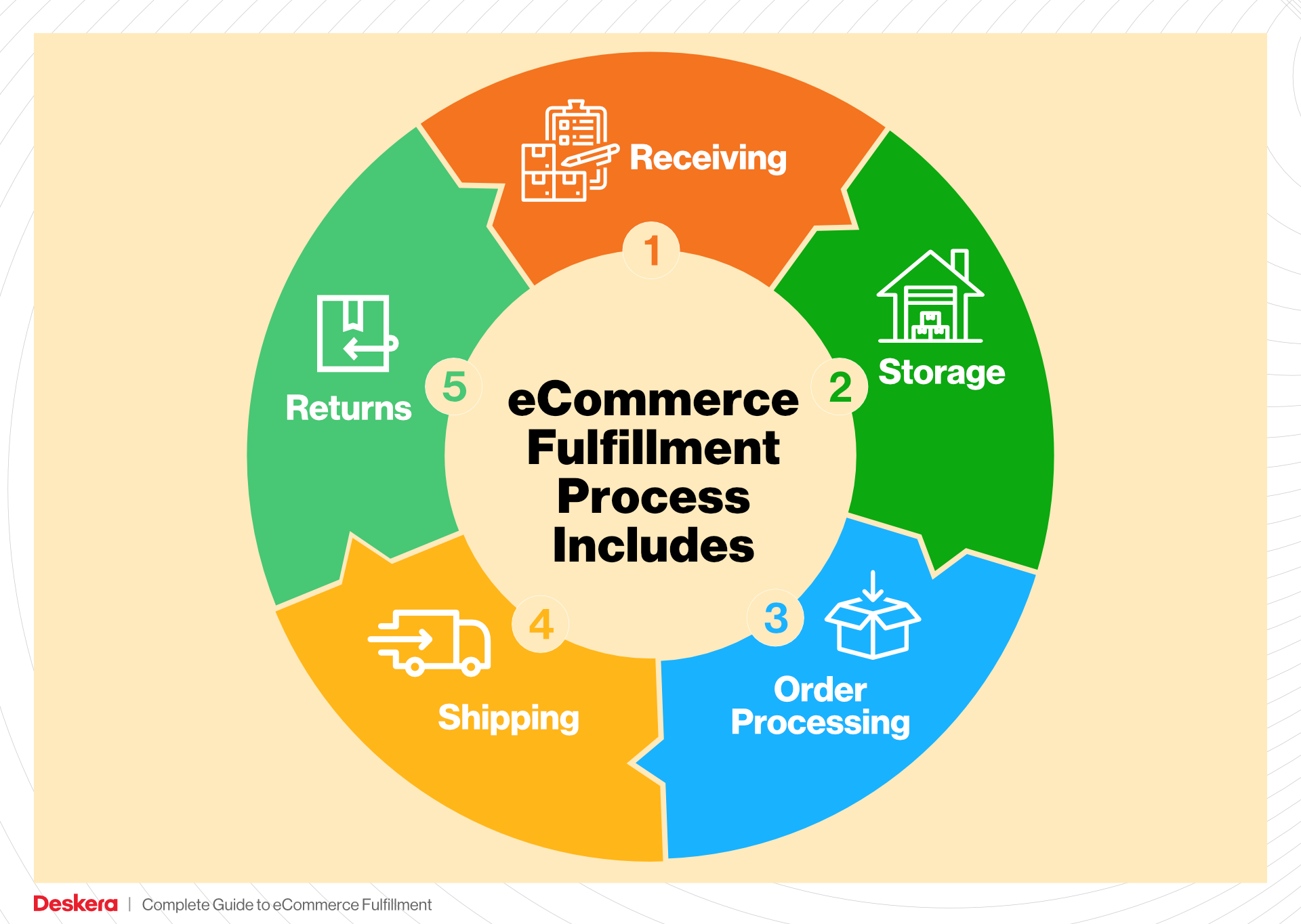
Ultimately, the goal of this guide is to empower you with the knowledge and tools necessary to make informed decisions about your logistics. By streamlining your fulfillment processes, you can enhance customer experiences, reduce operational headaches, and focus on scaling your business effectively. Let’s dive into the world of e-commerce fulfillment and discover how to optimize this critical aspect of your operations.
What You’ll Learn In This Guide
- What is E-commerce Fulfillment? An Introduction for Growing Businesses
- The Order Fulfillment Process: From ‘Buy’ Button to Customer’s Door
- Comparing Fulfillment Models: In-House vs. 3PL vs. Dropshipping
- A Deep Dive into Amazon FBA: Pros, Cons, and Who It’s For
- Core Services Offered by Fulfillment Centers
- How to Choose a Fulfillment Partner: A 6-Point Checklist
- Understanding Fulfillment Pricing: A Breakdown of Common Fees
- Frequently Asked Questions (FAQs) about Fulfillment
- Conclusion: Is Outsourcing Fulfillment the Right Move for Your Business?
- Important Disclaimer
The Order Fulfillment Process: From ‘Buy’ Button to Customer’s Door
1. Receiving Inventory
The order fulfillment process begins with receiving inventory, which is a critical step in ensuring that your warehouse is stocked with the products your customers want. When inventory arrives, it undergoes a thorough inspection to verify that the correct quantities and types of products have been received. This is where the concept of Stock Keeping Unit (SKU) comes into play, as each product is assigned a unique SKU for easy tracking.
Why It’s Important: Properly receiving inventory helps prevent stock discrepancies, reduces returns, and ensures that you can fulfill customer orders promptly. If products are not received correctly, it can lead to delays and dissatisfied customers.
Key Term: SKU (Stock Keeping Unit) – A unique identifier for each distinct product and service that can be purchased.
2. Warehouse Storage
Once the inventory has been received and verified, it is then stored in the warehouse. Efficient storage is essential for quick access and picking later in the fulfillment process. Warehouses often utilize various storage systems, such as pallet racking or shelving, and may employ technology like Warehouse Management Systems (WMS) to optimize storage space and improve inventory accuracy.
Why It’s Important: The organization of warehouse storage directly impacts how quickly orders can be fulfilled. A well-organized warehouse minimizes the time spent searching for products and enhances overall operational efficiency.
Key Term: Warehouse Management System (WMS) – Software that helps manage and optimize warehouse operations, including inventory tracking and storage organization.
3. Order Picking
Once a customer places an order, the next step is order picking. This involves selecting the correct items from their storage locations based on the order details. Pick lists are often generated to guide warehouse staff in efficiently gathering the items needed for each order.
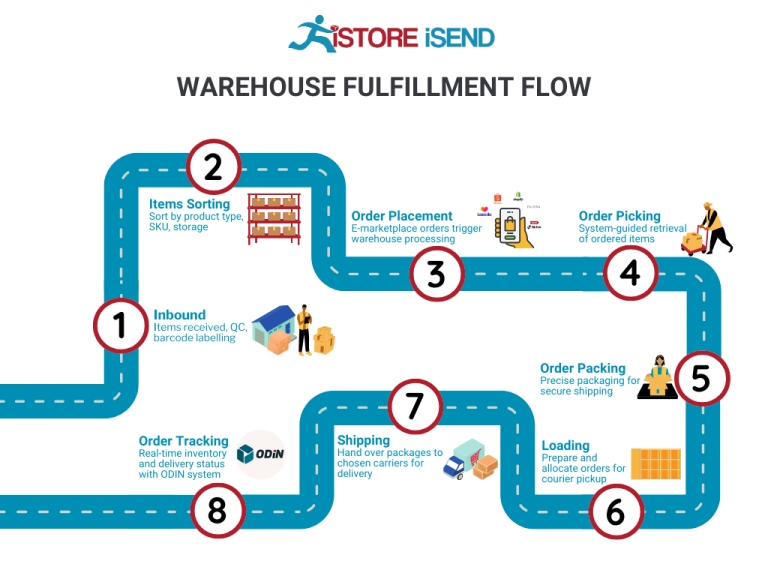
Why It’s Important: Effective order picking is crucial for maintaining order accuracy and speed. Errors in picking can lead to wrong items being sent, resulting in returns and customer dissatisfaction. Streamlining this process ensures that orders are fulfilled quickly and correctly, enhancing customer experience.
Key Term: Pick List – A document that outlines the items to be picked for each order, helping warehouse staff efficiently gather products.
4. Order Packing
After the items have been picked, they are moved to the packing station where they are prepared for shipment. Packing involves placing the items in appropriate packaging materials, labeling them correctly, and including any necessary documentation such as packing slips. The use of protective materials is also vital to ensure items arrive at their destination without damage.
Why It’s Important: Proper packing safeguards products during transit and can significantly influence customer satisfaction. A well-packed order not only reduces the likelihood of damage but also enhances the unboxing experience for customers, which can strengthen brand loyalty.
Key Term: Packing Slip – A document included in the package that lists the items contained within, serving as a confirmation of what has been shipped.
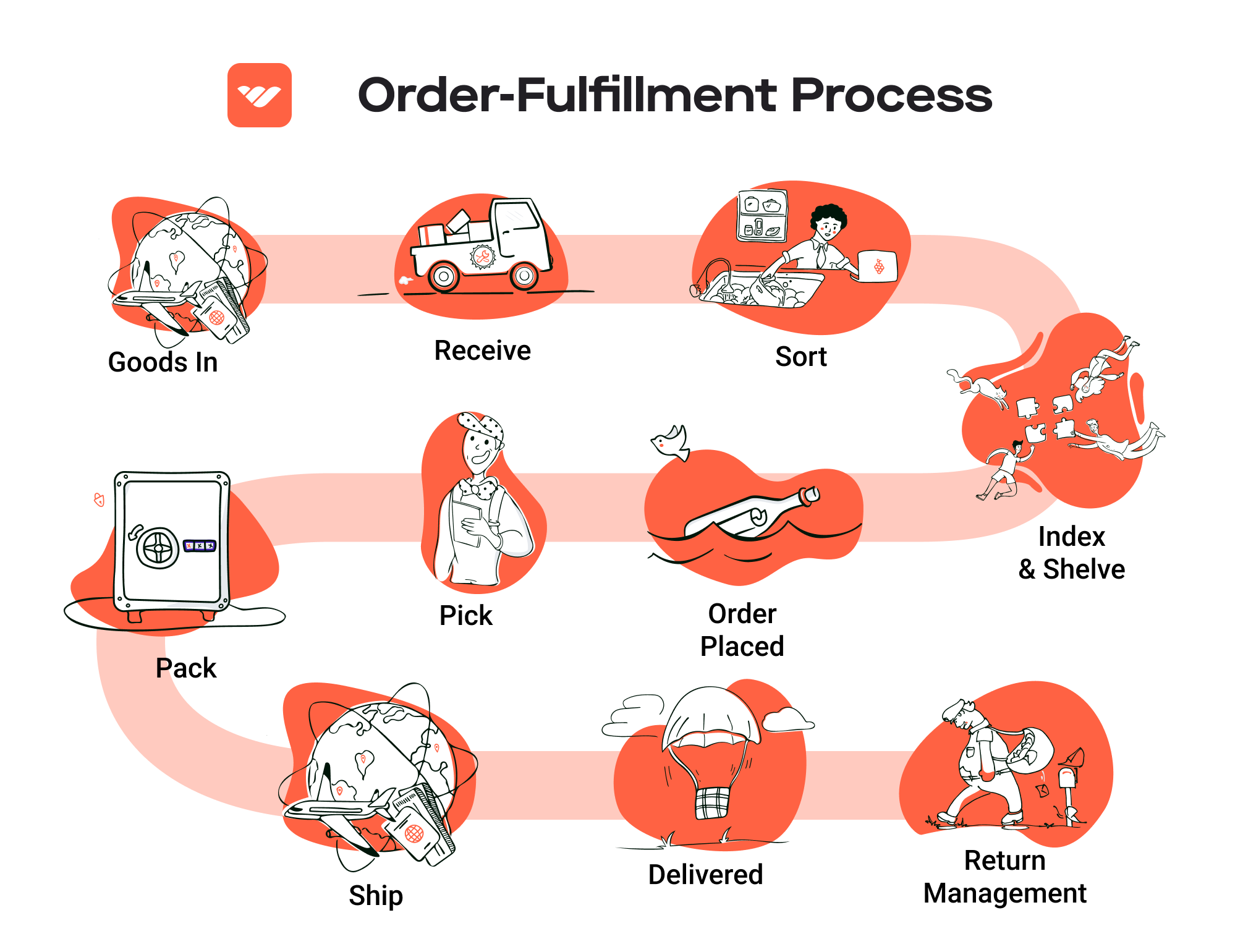
5. Shipping & Delivery
The final step in the order fulfillment process is shipping and delivery. Once the order is packed, it is handed over to a shipping carrier for transport to the customer. This step may involve choosing the most cost-effective and timely shipping options, as well as tracking shipments to ensure timely delivery.
Why It’s Important: Fast and reliable shipping is a key factor in customer satisfaction. In today’s e-commerce landscape, consumers expect quick delivery times, often within 1-2 days. Failure to meet these expectations can lead to negative reviews and lost customers.
Key Term: Last Mile Delivery – The final step of the delivery process where the package is transported from a transportation hub to the final delivery destination, often considered the most challenging part of the logistics chain.
By understanding and optimizing each step of the order fulfillment process—from receiving inventory to shipping and delivery—e-commerce businesses can enhance their operational efficiency, improve customer satisfaction, and ultimately scale their logistics effectively. Each stage plays a vital role in ensuring that customers receive their orders promptly and accurately, contributing to the overall success of the business.
Comparing Fulfillment Models: In-House vs. 3PL vs. Dropshipping
Comparing Fulfillment Models
| Model | Who Handles Inventory | Best For (Business Stage) | Key Advantage | Key Disadvantage |
|---|---|---|---|---|
| In-House Fulfillment | The business itself | Established businesses | Full control over inventory and operations | High overhead costs and resource-intensive |
| Third-Party Logistics (3PL) | An external logistics provider | Growing businesses and startups | Scalability and expertise in logistics | Less control over inventory and fulfillment speed |
| Dropshipping | Suppliers or manufacturers | Startups and businesses testing markets | Low upfront investment and minimal risk | Lower profit margins and potential quality issues |
In-House Fulfillment
In-house fulfillment involves managing the entire inventory and order fulfillment process within your own business operations. This model is typically adopted by established businesses that have the resources to maintain their own warehousing and logistics operations. The key advantage of in-house fulfillment is the complete control it offers over inventory management, order processing, and shipping. Businesses can tailor their processes to meet specific customer needs, which can enhance the customer experience and build brand loyalty. Additionally, having the inventory on hand allows for faster processing times and the flexibility to handle returns efficiently.
However, this model comes with significant disadvantages. The overhead costs associated with maintaining a warehouse, hiring staff, and investing in logistics technology can be substantial. Furthermore, in-house fulfillment can be resource-intensive, requiring significant time and management focus that could otherwise be directed towards core business activities such as marketing and product development. For businesses looking to scale quickly or those with fluctuating sales volumes, in-house fulfillment may not be the most efficient approach.
Third-Party Logistics (3PL)
Third-party logistics, or 3PL, involves outsourcing the storage, shipping, and fulfillment processes to a specialized logistics provider. This model is particularly suitable for growing businesses and startups that need to scale quickly without the burden of managing their own logistics. The key advantage of using a 3PL provider is the scalability it offers. Businesses can easily increase their storage space and fulfillment capabilities as their order volume grows, allowing them to focus on their core competencies while leveraging the expertise of logistics professionals.
3PL providers also bring advanced technology and logistics solutions that can enhance operational efficiency. They typically offer services such as inventory management systems, order tracking, and integration with various e-commerce platforms. However, the main drawback of using a 3PL provider is the loss of direct control over inventory and fulfillment speed. Businesses may face delays or issues that arise from relying on an external partner, which can negatively impact customer satisfaction. Additionally, costs can accumulate based on the services utilized, making it essential for businesses to carefully evaluate potential 3PL partners.
Dropshipping
Dropshipping is a fulfillment model where the retailer does not keep goods in stock but instead transfers customer orders and shipment details to a manufacturer or wholesaler, who then ships the products directly to the customer. This model is particularly advantageous for startups and businesses looking to test the market without significant upfront investment in inventory. The primary benefit of dropshipping is the minimal risk involved; businesses do not have to purchase inventory upfront, which reduces financial exposure.
Additionally, dropshipping allows for a wide variety of products to be offered without the need for warehousing, making it an attractive option for entrepreneurs looking to enter competitive markets. However, dropshipping also presents significant challenges. Profit margins can be lower compared to other fulfillment models, as retailers often rely on suppliers for pricing. Moreover, issues related to product quality, shipping delays, and inventory management can arise, potentially harming the retailer’s reputation. The lack of control over the fulfillment process can lead to customer dissatisfaction if not managed carefully.
Conclusion
When selecting a fulfillment model, e-commerce business owners must carefully consider their current business stage, operational capabilities, and long-term growth objectives. In-house fulfillment offers maximum control but comes with higher costs and resource demands. 3PL provides scalability and expertise but at the expense of direct oversight. Dropshipping presents a low-risk entry point into the market, though it can limit profit margins and quality control. Ultimately, the right fulfillment model will depend on the unique needs and goals of each business as they navigate the complexities of e-commerce operations.
A Deep Dive into Amazon FBA: Pros, Cons, and Who It’s For
Understanding Fulfillment by Amazon (FBA)
Fulfillment by Amazon (FBA) is a service provided by Amazon that allows sellers to store their products in Amazon’s fulfillment centers. Amazon takes care of storage, packaging, shipping, and customer service on behalf of the sellers. This service is particularly beneficial for e-commerce businesses looking to streamline their operations and reach a larger audience.
How FBA Works
When a seller enrolls in the FBA program, they send their products to Amazon’s warehouses. Once the products are stored, they become eligible for Amazon’s Prime and other customer-centric services. When a customer places an order, Amazon picks, packs, and ships the product directly to the customer. Additionally, Amazon handles all customer service inquiries and returns for FBA orders.
The process can be broken down into several key steps:
-
Product Preparation: Sellers must prepare their products according to Amazon’s guidelines, including labeling and packaging.
-
Shipping to Amazon: Sellers ship their products to Amazon’s fulfillment centers. Amazon provides guidance on how to create a shipment plan and which fulfillment center to use.
-
Storage and Inventory Management: Once received, the products are stored in Amazon’s warehouses. Sellers can monitor their inventory levels through the Amazon Seller Central dashboard.
-
Order Fulfillment: When a customer orders a product, Amazon automatically processes the order, picks the item from the inventory, packs it, and ships it to the customer.
-
Customer Service and Returns: Amazon manages all customer inquiries and returns, simplifying the process for sellers.
Pros of Using FBA
- Prime Eligibility:
-
Products fulfilled by Amazon are eligible for Amazon Prime, which can significantly increase sales. Prime members often prefer Prime-eligible products due to faster shipping options, leading to higher conversion rates for sellers.
-
Customer Trust:
-
Amazon’s reputation for customer service and reliability extends to FBA sellers. Customers feel confident purchasing products fulfilled by Amazon, which can improve sales and customer loyalty.
-
Multi-Channel Fulfillment:
-
FBA allows sellers to fulfill orders from other sales channels, such as their own websites or other marketplaces, using Amazon’s logistics infrastructure. This capability can simplify operations and reduce shipping costs.
-
Scalability:
-
FBA enables sellers to scale their operations without the need for additional warehousing or logistics management. As sales increase, Amazon can handle the increased volume, allowing sellers to focus on growth.
-
Simplified Logistics:
- FBA streamlines the entire logistics process, from storage to shipping, which can be particularly beneficial for small and medium-sized businesses that lack the resources to manage logistics efficiently.
Cons of Using FBA
- High Fees:
-
While FBA can simplify logistics, it comes with various fees, including storage fees, fulfillment fees, and potential additional costs for long-term storage. These fees can eat into profit margins, especially for low-priced items.
-
Strict Inventory Rules:
-
Amazon has stringent guidelines regarding inventory management, including requirements for labeling, packaging, and product condition. Failing to comply can lead to additional fees or removal of inventory.
-
Commingling Risks:
-
FBA products are often commingled, meaning that your inventory may be mixed with other sellers’ products. This can lead to issues with product quality and returns, as customers may receive items from other sellers instead of yours.
-
Limited Control:
-
By using FBA, sellers relinquish a degree of control over the fulfillment process. Any issues that arise, such as shipping delays or inventory errors, will be managed by Amazon, which can be frustrating for sellers who prefer to handle these aspects themselves.
-
Dependency on Amazon:
- Sellers using FBA become dependent on Amazon’s platform and policies. Changes in Amazon’s algorithms, fee structures, or fulfillment processes can have a significant impact on a seller’s business.
Who is FBA Best For?
Fulfillment by Amazon is ideal for a variety of sellers, particularly those who meet certain criteria:
-
Small to Medium-Sized Businesses: FBA is well-suited for small and medium-sized businesses that want to scale quickly without investing heavily in logistics infrastructure. It allows them to tap into Amazon’s vast customer base and logistics capabilities.
-
E-commerce Entrepreneurs: New entrepreneurs who are just starting their e-commerce journey can benefit from FBA’s simplified logistics and customer service, allowing them to focus on product development and marketing.
-
Brands Looking to Build Trust: Brands that want to enhance their credibility and trust with consumers can leverage FBA to gain the advantages of Amazon’s reputation for customer service.
-
Sellers with Seasonal Products: Businesses with seasonal or fluctuating demand can benefit from FBA’s scalability, as they can easily adjust their inventory levels based on market demand.
-
Multi-Channel Sellers: Brands selling on multiple platforms will find FBA advantageous as it allows for streamlined fulfillment from various sales channels, reducing logistical complexities.
In conclusion, while Fulfillment by Amazon presents numerous advantages, it also comes with its share of challenges. Sellers must carefully consider their business model, product types, and operational capabilities before deciding if FBA is the right fit for them. Balancing the pros and cons will enable businesses to make informed decisions that align with their growth objectives.
Core Services Offered by Fulfillment Centers
Inventory Management & Warehousing
Inventory management and warehousing are fundamental services provided by fulfillment centers that ensure e-commerce businesses can effectively track and manage their stock levels. This service involves the systematic control of inventory, including receiving, storing, and monitoring products until they are sold.
What It Is: Fulfillment centers utilize sophisticated inventory management systems that provide real-time visibility into stock levels, product locations, and reorder points. These systems often integrate with e-commerce platforms, allowing businesses to have a consolidated view of their inventory across multiple sales channels.
Benefits:
– Accuracy and Efficiency: Automated inventory tracking reduces human error, ensuring that businesses maintain accurate stock levels. This accuracy helps prevent stockouts and overstock situations, both of which can lead to lost sales or increased holding costs.
– Cost Savings: By optimizing storage space and inventory turnover, fulfillment centers can help businesses minimize warehousing costs. Efficient inventory management can lead to lower operational costs and improved cash flow.
– Enhanced Customer Experience: With accurate inventory data, businesses can provide better service to their customers. They can avoid overselling items and ensure timely order fulfillment, thus enhancing customer satisfaction and loyalty.
Pick and Pack Services
Pick and pack services are critical in the fulfillment process, particularly for e-commerce businesses that handle a wide range of products. This service involves selecting the correct items from the warehouse (picking) and packaging them appropriately for shipment (packing).
What It Is: Fulfillment centers employ trained staff and advanced technology to pick items based on incoming orders. After picking, items are carefully packed to ensure they arrive safely at their destination, using suitable materials that reflect the brand’s identity.
Benefits:
– Speed and Scalability: Fulfillment centers can process orders quickly, often within hours, which is essential for meeting consumer expectations for fast shipping. As businesses grow, these centers can easily scale their operations to handle increased order volumes without compromising service quality.
– Cost Efficiency: By outsourcing pick and pack operations, businesses can reduce labor costs and overhead associated with in-house fulfillment. Fulfillment centers can negotiate better shipping rates with carriers due to their volume, passing on those savings to their clients.
– Quality Control: Fulfillment centers often implement quality checks during the picking and packing process to ensure that customers receive the correct items in good condition. This reduces return rates and enhances brand reputation.
Kitting and Assembly
Kitting and assembly services are designed for e-commerce businesses that sell products that require assembly or packaging as a set. This service involves grouping various items together into a single kit or preparing a product for assembly before it is shipped.
What It Is: Kitting involves combining individual items into a ready-to-sell package. Assembly may include putting together components of a product before it is shipped to the customer. Fulfillment centers have the expertise and equipment to handle these processes efficiently.
Benefits:
– Customization: Kitting allows businesses to create personalized offerings, such as gift sets or bundled products, which can increase average order value and enhance customer satisfaction.
– Reduced Complexity: By outsourcing kitting and assembly, businesses can focus on core operations like marketing and sales rather than the logistical complexities of product preparation. Fulfillment centers streamline these processes, allowing for more efficient operations.
– Increased Sales Opportunities: Offering kits or assembled products can attract customers looking for convenience. This not only boosts sales but also helps businesses stand out in competitive markets.
Returns Management (Reverse Logistics)
Returns management, or reverse logistics, is an essential service for e-commerce businesses, particularly in markets with high return rates. This service involves handling product returns efficiently and effectively.
What It Is: Fulfillment centers manage the entire returns process, from receiving returned items to inspecting, restocking, or disposing of them based on predefined criteria. They also handle customer communications regarding returns, ensuring a smooth process for customers.
Benefits:
– Enhanced Customer Experience: A streamlined returns process can significantly improve customer satisfaction. Quick and hassle-free returns encourage repeat purchases and can help build brand loyalty.
– Operational Efficiency: By outsourcing returns management, businesses can reduce the strain on their internal resources. Fulfillment centers have the infrastructure and expertise to manage returns efficiently, minimizing processing time and costs.
– Data Insights: Fulfillment centers can provide valuable insights into return reasons and patterns, helping businesses identify product issues or customer dissatisfaction. This data is crucial for making informed decisions about product offerings and customer service improvements.
In conclusion, partnering with a fulfillment center that offers comprehensive services like inventory management, pick and pack, kitting, and returns management can significantly enhance an e-commerce business’s operational efficiency and customer satisfaction. By leveraging these core services, businesses can focus on growth and scaling while ensuring their logistics and fulfillment processes are handled professionally.
How to Choose a Fulfillment Partner: A 6-Point Checklist
Location & Warehouse Network
Importance: The geographical location of your fulfillment partner’s warehouses is crucial for minimizing shipping times and costs. In e-commerce, speed is of the essence, especially in markets like South Korea, where consumers expect rapid delivery—often within 1-2 days.
Questions to Ask:
– Where are your warehouses located, and how does this impact shipping times to my target customers?
– Do you have facilities near major urban centers?
– How do you handle logistics for international shipping if my business expands beyond South Korea?
Technology & Integrations
Importance: A fulfillment partner’s technology capabilities are vital for efficient operations. Advanced systems can streamline order processing, inventory management, and tracking. Integration with your e-commerce platform is essential for real-time updates and seamless operations.
Questions to Ask:
– What warehouse management system (WMS) do you use, and how does it integrate with popular e-commerce platforms?
– Can you provide API access for real-time order tracking and inventory updates?
– How do you manage data security and compliance with local regulations?
Specializations (e.g., Cold Storage, Oversized Items)
Importance: Depending on your product range, you may require specific capabilities from your fulfillment partner. For example, businesses dealing in perishables or oversized items need partners with specialized facilities and handling processes.
Questions to Ask:
– Do you offer specialized services such as cold storage or handling oversized products?
– What certifications or standards do you meet for specific product categories?
– Can you accommodate unique packing and shipping requirements for my products?
Scalability & Capacity
Importance: As your business grows, your fulfillment partner should be able to scale alongside you. This includes having the capacity to handle increased order volumes, seasonal spikes, or new product lines without compromising service quality.
Questions to Ask:
– What is your current capacity, and how do you handle peak seasons?
– Can you provide examples of how you have scaled operations for other clients?
– Are there any limits to the number of SKUs or volume of orders you can handle?
Pricing and Contracts
Importance: Understanding pricing structures and contract terms is essential for budgeting and financial planning. Hidden fees or unfavorable contract terms can significantly impact your margins.
Questions to Ask:
– What is your pricing model for storage, order fulfillment, and shipping?
– Are there any additional fees for services like returns processing or special packaging?
– What are the terms of your contract? Is there flexibility for renegotiation or termination?
Customer Support & Reviews
Importance: Strong customer support is critical for resolving issues quickly and maintaining smooth operations. Additionally, researching reviews can provide insights into a partner’s reliability and service quality.
Questions to Ask:
– What customer support channels do you offer (e.g., phone, email, chat)?
– Can you provide references or case studies from similar businesses?
– How do you handle customer complaints or fulfillment errors?
Conclusion
Choosing the right fulfillment partner is a strategic decision that can significantly impact your e-commerce business’s success. By carefully evaluating these six critical areas—location and warehouse network, technology and integrations, specializations, scalability, pricing, and customer support—you can make an informed choice that aligns with your business goals. Prioritize partners that not only meet your current needs but can also support your growth in an evolving market.
Understanding Fulfillment Pricing: A Breakdown of Common Fees
Initial Setup Fees
Initial setup fees are often the first costs you encounter when partnering with a fulfillment service. These fees cover the onboarding process, which typically includes account creation, integration with your e-commerce platforms, and any necessary training for your staff on how to use the fulfillment service’s systems.
The exact amount can vary significantly based on the complexity of your operations and the specific requirements of the fulfillment center. For instance, if you are a new business requiring a basic setup, fees may range from $100 to $300. However, if you need custom integrations or extensive training, costs could escalate to $1,000 or more. It’s crucial to clarify what is included in these fees upfront, as some providers might charge for additional services that are essential for your operations.
Receiving Fees
Receiving fees are charged when the fulfillment center accepts and processes your inventory. This fee typically covers the labor involved in unloading goods, inspecting them for damage, and entering them into the inventory management system.
The calculation of receiving fees can depend on various factors, including the volume of goods and the complexity of the receiving process. Some fulfillment centers might charge a flat fee per shipment (e.g., $50), while others may charge based on the number of pallets or boxes received, which can range from $10 to $30 per pallet. Understanding the specifics of how these fees are structured will help you manage your costs effectively.
Storage Fees (per pallet/bin)
Storage fees are a recurring expense that e-commerce businesses need to factor into their fulfillment costs. These fees are charged for the space your products occupy in the fulfillment center’s warehouse.
Typically, storage fees are calculated on a monthly basis and can be charged per pallet or per bin, depending on how your products are stored. For example, you might see rates like $20 to $50 per pallet per month. If your products are smaller and stored in bins, the fees might be lower, ranging from $5 to $15 per bin. It’s also important to inquire about any potential long-term storage fees, which can be applied if your inventory remains in the warehouse for an extended period (often over six months).
Pick & Pack Fees (per item/order)
Pick and pack fees refer to the costs associated with retrieving items from the warehouse and preparing them for shipping. This process includes picking the right products, packing them appropriately, and labeling them for delivery.
These fees can vary widely depending on the fulfillment center’s pricing structure. Some providers may charge a flat fee per order (e.g., $1 to $3 per order), while others charge based on the number of items picked and packed. For instance, you may encounter fees like $0.50 to $1.50 per item. Understanding how these fees are calculated is crucial, as they can significantly impact your overall fulfillment costs, especially if you have a diverse product range.
Shipping Fees
Shipping fees are the final piece of the fulfillment pricing puzzle and can often be the most variable. These fees cover the costs of transporting your products from the fulfillment center to your customers.
Shipping fees can depend on several factors, including the destination, weight, and dimensions of the package, as well as the shipping method chosen (standard, expedited, etc.). Many fulfillment centers have negotiated rates with carriers, which can result in lower shipping costs for you. It’s common to see shipping fees ranging from $5 to $20 for domestic deliveries, with international shipping costs being higher depending on the country. Make sure to clarify whether these fees are included in your fulfillment agreement or if they will be billed separately.
Tips for Getting an Accurate Quote
-
Provide Detailed Information: When requesting quotes, be as specific as possible about your business model, product dimensions, and anticipated order volumes. This helps fulfillment centers give you a more accurate estimate.
-
Ask About Hidden Fees: Inquire about any additional costs that might not be included in the initial quote, such as long-term storage fees, return processing fees, or fees for special handling.
-
Compare Multiple Providers: Don’t settle for the first quote you receive. Compare pricing and services from multiple fulfillment providers to find the best fit for your business.
-
Negotiate Terms: Some fulfillment centers may be open to negotiation, especially if you can commit to a certain volume of business. Don’t hesitate to ask for discounts or better rates.
-
Review Contract Terms: Ensure you understand the terms of the contract, especially regarding pricing structures and potential increases in fees over time.
By taking these steps, you can ensure you receive a comprehensive and accurate quote that reflects the true cost of fulfillment for your e-commerce business.
Frequently Asked Questions (FAQs) about Fulfillment
1. What is fulfillment in the context of e-commerce in South Korea?
Fulfillment in e-commerce refers to the process of storing, picking, packing, and shipping products to customers. In South Korea, it involves leveraging advanced logistics networks and technology to ensure fast and efficient delivery, often within 1-2 days, to meet consumer expectations.
2. What’s the difference between a warehouse and a fulfillment center?
A warehouse primarily serves as a storage space for inventory, while a fulfillment center is a specialized facility designed to handle the entire order processing cycle. Fulfillment centers focus on quick turnaround, including picking, packing, and shipping directly to customers, often integrating advanced technology for inventory management and order tracking.
3. What is a 3PL (Third-Party Logistics) provider?
A 3PL provider is a company that offers outsourced logistics services, including warehousing, fulfillment, and distribution. In South Korea, partnering with a 3PL can help e-commerce businesses streamline their operations, reduce costs, and enhance delivery speed, crucial for competing in the fast-paced market.
4. How much do fulfillment services cost in South Korea?
Fulfillment costs in South Korea can vary widely based on services provided. On average, storage fees can range from ₩8,000 to ₩30,000 per pallet per month, while order processing fees typically range from ₩600 to ₩1,800 per order. Additional shipping costs depend on the distance and weight of the packages.
5. Why should I choose a fulfillment service in South Korea?
Using a local fulfillment service in South Korea can significantly enhance your business’s efficiency by reducing shipping times, improving customer satisfaction, and lowering operational costs. Given the high demand for fast delivery in the Korean e-commerce market, local fulfillment can be a competitive advantage.
6. How does technology impact fulfillment services in South Korea?
Technology plays a vital role in South Korean fulfillment services, with many providers using automated systems for inventory management, order processing, and real-time tracking. This integration helps businesses optimize their supply chain, reduce errors, and enhance the overall customer experience.
7. Can fulfillment services support cross-border e-commerce?
Yes, many fulfillment services in South Korea are equipped to handle cross-border e-commerce. They provide support for customs clearance, international shipping, and compliance with local regulations, making it easier for businesses to reach customers in different countries.
8. What should I consider when choosing a fulfillment partner in South Korea?
When selecting a fulfillment partner, consider their location relative to major urban centers, their technology capabilities, service offerings, scalability, and experience with international businesses. Additionally, assess their ability to provide customer support in your preferred language and their understanding of local market dynamics.
9. How do I ensure quick order processing in fulfillment?
To ensure quick order processing, choose a fulfillment service that prioritizes efficiency and has the capability to process orders within 24 hours. Look for providers with strategically located warehouses, advanced picking and packing technology, and a strong logistics network to minimize delays.
10. What are the benefits of localizing my fulfillment operations in South Korea?
Localizing your fulfillment operations in South Korea can lead to faster delivery times, improved customer satisfaction, and reduced shipping costs. It also allows you to better understand local market trends, customer preferences, and regulatory requirements, ultimately strengthening your brand’s presence in the region.
Conclusion: Is Outsourcing Fulfillment the Right Move for Your Business?
The Strategic Choice of Outsourcing Fulfillment
Outsourcing fulfillment can be a transformative decision for e-commerce businesses aiming to scale efficiently. By partnering with a fulfillment service, you can unlock several key benefits that directly impact your operational effectiveness and customer satisfaction.
Firstly, outsourcing saves valuable time. Handling logistics in-house often diverts focus from core business activities like product development and marketing. A dedicated fulfillment partner takes over warehousing, order processing, and shipping, allowing you to concentrate on growth strategies and customer engagement.
Secondly, scalability becomes seamless with the right fulfillment service. As your business grows, so do your logistics needs. Fulfillment providers are equipped to handle fluctuations in order volumes, ensuring that you can meet customer demands without the hassle of expanding your own warehouse space or workforce. This flexibility is crucial for maintaining a competitive edge, especially in fast-paced markets like South Korea.
Moreover, these partners bring expertise to the table. Many fulfillment services operate with advanced technology, such as automated inventory management systems and data analytics, which can enhance operational efficiency and reduce errors. Their experience in navigating local regulations and customs can significantly streamline cross-border shipping, which is invaluable for international sellers looking to penetrate the Korean market.
However, the success of outsourcing fulfillment hinges on choosing the right partner. It’s essential to assess potential providers based on their capabilities, technological integration, and ability to align with your business goals. Prioritize those with a proven track record in your industry and a clear understanding of your customer base.
As you consider these factors, take a moment to audit your current shipping processes. Are they efficient? Are they scalable? Reflecting on these questions can help you determine if a fulfillment partner is the right next step for your business growth. Embrace the opportunity to optimize your operations and enhance customer satisfaction through strategic outsourcing.
Important Disclaimer
⚠️ Important Disclaimer
The information in this guide is for educational purposes. Fulfillment services, pricing, and platform features change frequently. Always conduct your own due diligence and consult with providers directly before making business decisions.
